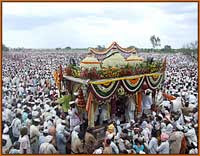Waari is the term used to refer holy pilgrimage in Maharashtra and the word is synonymous with Pandharpur Yatra to the famous Lord Vitthal Temple
The followers of Sanatana Dharma (Hinduism) never bothered about dates and why would they bother, when their sole aim is to understand Brahman – the timeless – and merge with it. Same is the case with the Pandharpur Wari tradition and no one knows exactly when the first Pandharpur Yatra took place so many people roughly say it is thousand years old.
Some believe it was the parents of Sant Dnyaneshwar who undertook the first pilgrimage in the 13th century. Sant Dnyaneshwar too did the pilgrimage and it became a tradition.
Saint Dnyaneshwar during his pilgrimage came into contact with common man and through his traditional spiritual songs sang the glory of Lord Vitthal, an incarnation of Krishna . He broke the Brahmanical shackles and monopoly over Hindu scriptures and translated especially the Gita into the language of the common man and popularized it.
The next noted saint who undertook the Pandharpur Wari was Sant Tukaram. Saint Tukaram was pious soul who spread the message of Bhakti among the poor Maharashtrians in rural areas.
In 1685, the youngest son of Tukaram introduced the Palkhi (palanquin) tradition. The ‘palkhi’ tradition involves the carrying of the silver padukas (footsteps) in a palanquin during the pilgrimage from Dehu near Pune to Pandharpur. He also took the padukas of Saint Dnyaneshwar from Alandi in a palanquin.
The tradition of the twin palkhis continued till 1830 but was stopped in 1830 due to some internal strife in the Tukaram family. Elders in order to avoid problems in future broke-up the tradition of the twin palkhis. They decided to organize two separate palkhis. And thus we have today Sant Tukaram Palkhi from Dehu near Pune and the Sant Dnyaneshwar Palkhi from Alandi.
Today, apart from the Tukaram and Dnyaneshwar palkhi nearly 40 other palkis take part in the yatra. Nearly 250 groups, referred as ‘Dindis,’ join it from various places on the way. It is estimated that nearly half-a-million people participate in the Pandharpur Wari. The Yatra also takes place during the Kartik Ekadashi (November).
